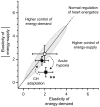Improved energy supply regulation in chronic hypoxic mouse counteracts hypoxia-induced altered cardiac energetics
- PMID: 20174637
- PMCID: PMC2823784
- DOI: 10.1371/journal.pone.0009306
Improved energy supply regulation in chronic hypoxic mouse counteracts hypoxia-induced altered cardiac energetics
Abstract
Background: Hypoxic states of the cardiovacular system are undoubtedly associated with the most frequent diseases of modern time. Therefore, understanding hypoxic resistance encountered after physiological adaptation such as chronic hypoxia, is crucial to better deal with hypoxic insult. In this study, we examine the role of energetic modifications induced by chronic hypoxia (CH) in the higher tolerance to oxygen deprivation.
Methodology/principal findings: Swiss mice were exposed to a simulated altitude of 5500 m in a barochamber for 21 days. Isolated perfused hearts were used to study the effects of a decreased oxygen concentration in the perfusate on contractile performance (RPP) and phosphocreatine (PCr) concentration (assessed by (31)P-NMR), and to describe the integrated changes in cardiac energetics regulation by using Modular Control Analysis (MoCA). Oxygen reduction induced a concomitant decrease in RPP (-46%) and in [PCr] (-23%) in Control hearts while CH hearts energetics was unchanged. MoCA demonstrated that this adaptation to hypoxia is the direct consequence of the higher responsiveness (elasticity) of ATP production of CH hearts compared with Controls (-1.88+/-0.38 vs -0.89+/-0.41, p<0.01) measured under low oxygen perfusion. This higher elasticity induces an improved response of energy supply to cellular energy demand. The result is the conservation of a healthy control pattern of contraction in CH hearts, whereas Control hearts are severely controlled by energy supply.
Conclusions/significance: As suggested by the present study, the mechanisms responsible for this increase in elasticity and the consequent improved ability of CH heart metabolism to respond to oxygen deprivation could participate to limit the damages induced by hypoxia.
Conflict of interest statement
Figures




Similar articles
-
Modular control analysis of effects of chronic hypoxia on mouse heart.Am J Physiol Regul Integr Comp Physiol. 2008 Dec;295(6):R1891-7. doi: 10.1152/ajpregu.90548.2008. Epub 2008 Oct 1. Am J Physiol Regul Integr Comp Physiol. 2008. PMID: 18832083
-
Function and bioenergetics in isolated perfused trained rat hearts.Am J Physiol. 1997 Jan;272(1 Pt 2):H409-17. doi: 10.1152/ajpheart.1997.272.1.H409. Am J Physiol. 1997. PMID: 9038963
-
Adaptation to chronic hypoxia alters cardiac metabolic response to beta stimulation: novel face of phosphocreatine overshoot phenomenon.J Mol Cell Cardiol. 1995 Aug;27(8):1679-87. doi: 10.1016/s0022-2828(95)90755-6. J Mol Cell Cardiol. 1995. PMID: 8523430
-
Integrative methods for studying cardiac energetics.Methods Mol Biol. 2015;1264:289-303. doi: 10.1007/978-1-4939-2257-4_26. Methods Mol Biol. 2015. PMID: 25631023 Review.
-
Oxygen demand of perfused heart preparations: how electromechanical function and inadequate oxygenation affect physiology and optical measurements.Exp Physiol. 2015 Jun;100(6):603-16. doi: 10.1113/EP085042. Exp Physiol. 2015. PMID: 25865254 Free PMC article. Review.
Cited by
-
Mitochondrial network energetics in the heart.Wiley Interdiscip Rev Syst Biol Med. 2012 Nov-Dec;4(6):599-613. doi: 10.1002/wsbm.1188. Epub 2012 Aug 15. Wiley Interdiscip Rev Syst Biol Med. 2012. PMID: 22899654 Free PMC article. Review.
-
Integrative Methods for Studying Cardiac Energetics.Methods Mol Biol. 2021;2277:405-421. doi: 10.1007/978-1-0716-1270-5_25. Methods Mol Biol. 2021. PMID: 34080165
-
Mitaplatin increases sensitivity of tumor cells to cisplatin by inducing mitochondrial dysfunction.Mol Pharm. 2012 Mar 5;9(3):634-44. doi: 10.1021/mp200571k. Epub 2012 Feb 13. Mol Pharm. 2012. PMID: 22289032 Free PMC article.
-
Adaptive Cardiac Metabolism Under Chronic Hypoxia: Mechanism and Clinical Implications.Front Cell Dev Biol. 2021 Feb 2;9:625524. doi: 10.3389/fcell.2021.625524. eCollection 2021. Front Cell Dev Biol. 2021. PMID: 33604337 Free PMC article. Review.
-
Salubrinal protects against tunicamycin and hypoxia induced cardiomyocyte apoptosis via the PERK-eIF2α signaling pathway.J Geriatr Cardiol. 2012 Sep;9(3):258-68. doi: 10.3724/SP.J.1263.2012.02292. J Geriatr Cardiol. 2012. PMID: 23097656 Free PMC article.
References
-
- Gibbs JS. Biventricular function at high altitude: implications for regulation of stroke volume in chronic hypoxia. Adv Exp Med Biol. 2007;618:13–24. - PubMed
-
- Itoh A, Tomita H, Sano S. Doppler echocardiographic assessment of left ventricular diastolic function in chronic hypoxic rats. Acta Med Okayama. 2009;63:87–96. - PubMed
-
- Miraux S, Calmettes G, Massot P, Lefrancois W, Parzy E, et al. 4D retrospective black blood trueFISP imaging of mouse heart. Magn Reson Med. 2009;62:1099–1105. - PubMed
-
- Ostadal B, Kolar F. Cardiac adaptation to chronic high-altitude hypoxia: beneficial and adverse effects. Respir Physiol Neurobiol. 2007;158:224–236. - PubMed
Publication types
MeSH terms
Substances
LinkOut - more resources
Full Text Sources
Research Materials

